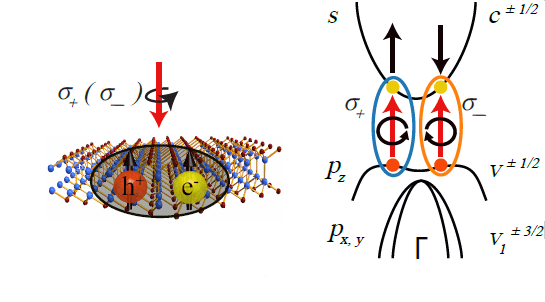The ability to dynamically control spin with polarized light offers opportunities for fast, nondestructive, and magnet free control over spin information. Manipulating spin with light has been achieved in III-V and II-VI semiconductors through spin polarized optical selection rules that occur due to strong atomic spin-orbit coupling in these systems [1]. Although these traditional systems have pioneered the field of optical spin-based devices, there are other novel platforms for optical spin control.
The emergence of two-dimensional van der Waals materials offers an alternative low-dimensional platform for spintronic phenomena. Indium selenide (InSe), a group-III monochalcogenide van der Waals material, has shown promise for optoelectronics due to its high electron mobility, tunable direct band gap, and quantum transport [2,3]. In addition to these properties, InSe has also been proven to have spin-polarized optical selection rules similar to that of III-V and II-VI semiconductors, allowing optical orientation of spin [4].Optical orientation of spin is an important prerequisite for optospintronic phenomena and devices, and these first demonstrations of layer-dependent optical excitation of spins in InSe lay the foundation for combining layer-dependent spin properties with advantageous electronic properties found in this material.

[1] I. Zutic, J. Fabian, and S. Das Sarma, “Spintronics: Fundamentals and applications,” Rev. Mod. Phys., vol. 76, pp. 323–410, 2 (2004).
[2] K. Premasiri and X. P. Gao, “Tuning spin-orbit coupling in 2D materials for spintronics: A topical review,” Journal of Physics Condensed Matter, vol. 31, no. 19 (2019)
[3] D. A. Bandurin, A. V. Tyurnina, G. L. Yu, et al., “High electron mobility, quantum Hall effect and anomalous optical response in atomically thin InSe,” Nature Nanotechnology, vol. 12, no. 3, pp. 223–227 (2017)
[4] J. Nelson, T. K. Stanev, D. Lebedev, et al., “Layer-dependent optically induced spin polarization in InSe,” Phys. Rev. B, vol. 107, p. 115 304, 11 (2023).
